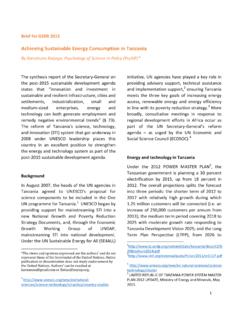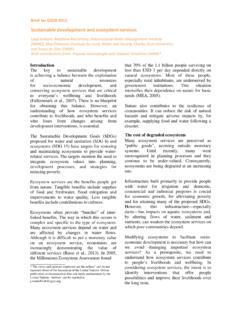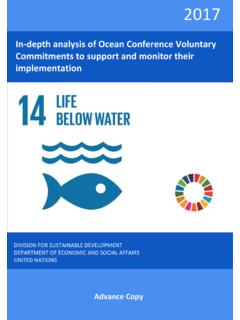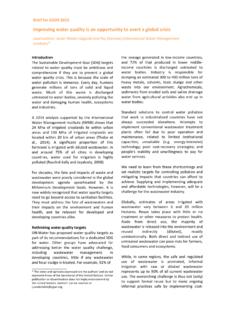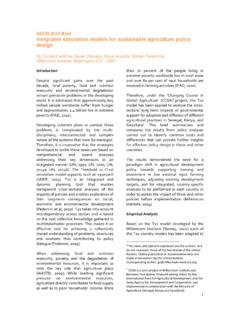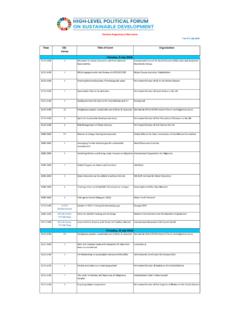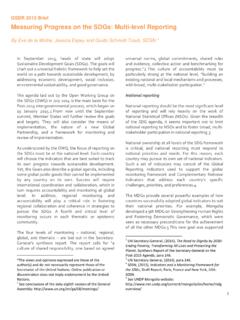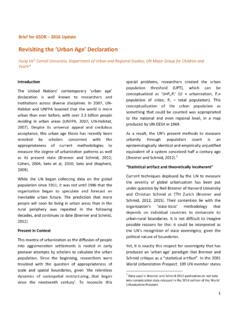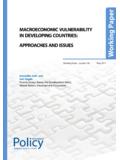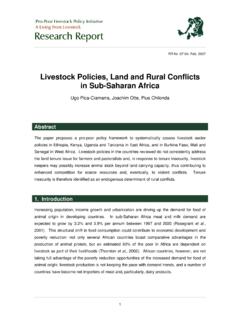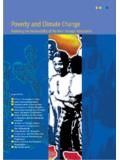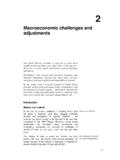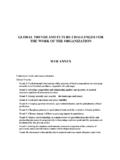Transcription of By Nora Sticzay and Larissa Koch, Wageningen …
1 1 GSDR 2015 Brief SLUM UPGRADING By Nora Sticzay and Larissa koch , Wageningen university and research Centre Related Sustainable Development Goals Goal 01 End poverty in all its forms everywhere Goal 03 Ensure healthy lives and promote well-being for all at all ages Goal 06 Ensure availability and sustainability management of water and sanitation for all Goal 08 Promote sustained, inclusive and sustainable economic growth, full and productive employment and decent work for all Goal 11 Make cities and human settlements inclusive, safe, resilient and sustainable Goal 17 Strengthen the means of implementation and revitalize the global partnership for sustainable development *The views and opinions expressed are the authors and do not represent those of the Secretariat of the United Nations. Online publication or dissemination does not imply endorsement by the United Nations.
2 Authors of the brief can be reached at and Introduction Currently, every seventh person worldwide lives in an informal urban settlement, summing up to 850 million people ,2,3 In some megacities of low- and middle-income countries almost 80% of the total population lives in Fast urbanization is observed worldwide but in developing countries it is expected adding up to billion in 2025 people living in ,6 Three-quarter of the world s population is expected to live in an urban environment by 2050, whereby urbanization in developing countries will be the most ,8 These facts illustrate that immediate action is required and this issue cannot be neglected, since slums will not be resolved but in fact increasing over the coming years. Based on the UN Millennium Goal Number 7 (directly 7D) on the improvement of slum dweller living conditions, several UN post-2015 Sustainable Development Goals (SDGs) are also trying to address this complex issue.
3 Informal settlements, also referred as slums or favelas in parts of Latin America, are unplanned, densely populated and neglected parts of cities where living conditions are extremely poor. The process of slum upgrading involves the improvement of both physical and social environment. In order to direct financial investments to the right place and problem, one must recognize the linkages between the undermining issues (Table 1).9 Yet, the different interplays of actors is also crucial for the holistic success. Projects show that tri-sector partnerships, include the state, private and voluntary sectors have to cooperate in order to overcome slum upgrading challenges (Appendix 2).10 Even though the enumerated parties show commitment, the urgent needs of individual slum dwellers and local communities also have to be considered.
4 In order to make slum upgrading successful on the long-term, enduring and strategic planning must be addressed in all financial, institutional and regulatory decisions to certain The fundamental issue in urban development and slum upgrading is related to the growing number of urban residents and how housing and infrastructure services can be financed for the future urban generations. Slum upgrading is complex and unclear, because several interrelated components (both physical and social environment) must be addressed that entail significantly different financial consequences: (a) infrastructure components like housing, water, sanitation, roads and footpaths, storm drainage, lightning or public phones, (b) service components like waste collection, schools, medical centers and (c) other services like social integration buildings, public spaces, peace building and poverty reduction ,13,14 There are several, individual aspects, FACTS & FIGURES By 2050, three-quarter of the world s population is expected to live in urban areas, with the highest urbanization rate in developing countries.
5 Community funds is the only instrument out of the demand-led approaches that has the potential to reach marginalized poor 2 which contribute to the understanding of the global challenge (Table 1). Notwithstanding the fast and semi-fast economic growth in most developing countries, extensive poverty remains the prime concern. Especially in urban poverty, the lack of well-paid employment is the most important factor. From the issues and challenges mentioned above, it can be concluded that conventional sources of finance will not be enough to meet the predicted requirements for urban infrastructure and The present financial system is not efficient. Therefore, we identified the following four reasons: (a) national subsidies are not effectively targeted to urban poor, (b) lacking land tenure rights usually exclude the very poor to access governmental subsidies and funds, (c) international funds are usually distributed through a ministry of finance and therefore top-down and centralized and (d) there is a limited usability of international and national funding for several purposes (earmarked funds).
6 16 Consequently, it is very important to note that financial innovation to reduce urban poverty and to upgrade slums is essential and it must occur with a policy shift from supply-driven to demand-led approaches. In this brief, a community-driven case study is described to show recent success in slum upgrading. Furthermore, different financial options for urban low-income households are listed and briefly explained by the use of real examples leading to a description of broad finance mechanisms. The brief will end with the opportunities and risks of blended finance of current slum upgrading finances are clarified and linked to the SDGs. Table 1. Sector-specific Issues and Challenges in urban development17 Issues & Challenges Demographic Socio-behavioral Economic Environmental Financial Governance Increasing demand for urban housing and infrastructure services due to more urban citizens in the future.
7 Cities as center location of financial services and knowledge economy but performance is related to livelihood: the quality of urban housing and infrastructure. Increase of social differentiation and increase of heterogeneous communities in urban areas: education, consumption and culture. Moving away from collective to individual cultural values due to growing ethnically diverse cities. Ethnically homogenous groups might exclude other communities. Unsecure tenure of slum dwellers. Domestic macroeconomic growth needed to provide the basis of urban development, but citywide microeconomic is as important as macroeconomic performance. Housing and infrastructure are critical key factors of the economic production function of cities yet national budgets for investment are generally too low. Global inequality between rich and poor.
8 Paradox: Cities are the center of productivity but also of increasing poverty linked to a lack of housing and infrastructure services. Growing demand for infrastructure puts pressure on natural resources. Increasing costs of potable water. Consumption of natural resources of urban residents is often faster than the environment s ability to reproduce. Management of human and solid waste. Current level of FDI, IDA and government financing are not meeting the demands for upgrading. Maintenance of housing and infrastructure services is frequently not included in budget plans, which would eventually decrease the new annual domestic investments. Formal financial institutions have no interest in general to go down-market and extend their lending to lower-income groups. Centralized and strict top-down approach to urban governance.
9 Limited participation of low-income groups in the national upgrading programs. Only a small part of the funding is addressing upgrading slums. 3 Case study The Asian Coalition for Community Action (ACCA) illustrates a successful case of a community fund saving instrument. It is demand-oriented in the provision of housing and infrastructure for low-income communities. ACCA was founded in 2008 by the Asian Coalition for Housing Rights (ACHR) and it has contributed to community-driven slum upgrading in more than 165 cities in 19 different Asian nations ever ACCA applies a clear budget ceiling strategy: it supports every city with a total amount of USD 58, In addition, it provides seed funds for community development funds (CDF) and a regional USD 50,000 revolving loan fund for every city.
10 Each community has the freedom to decide for which purpose the resources should be This small amount of money represents a motivation for slum dwellers to engage with the local municipality to leverage further public subsidies. Community finance mechanisms implemented by ACCA offer a reliable alternative in the provision of housing and infrastructure for marginalized communities, who are actually excluded from financial solutions and access to public services by the macroeconomic and institutional Compared to other forms of finance, community finance tends to be for shorter term and lending is collective to community members who borrow (Appendix3I). Together, the ACCA funding and regional community saving groups deposit money into the CDF, to which also the formal finance sector, such as governments, banks and international aid agencies In this way, two main things are accomplished: first of all, slum dweller community groups get a voice in projects by networking with various local or national authorities and development agencies.

